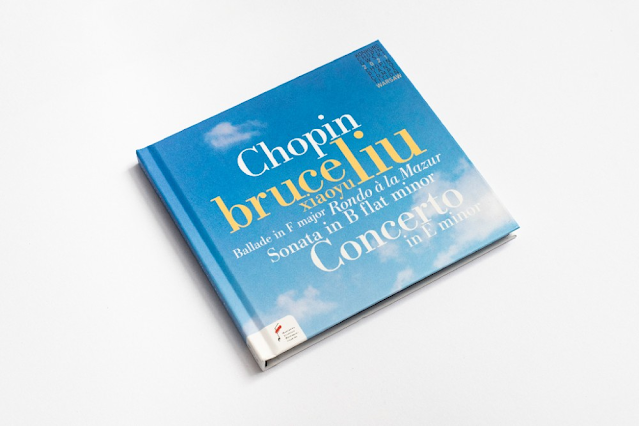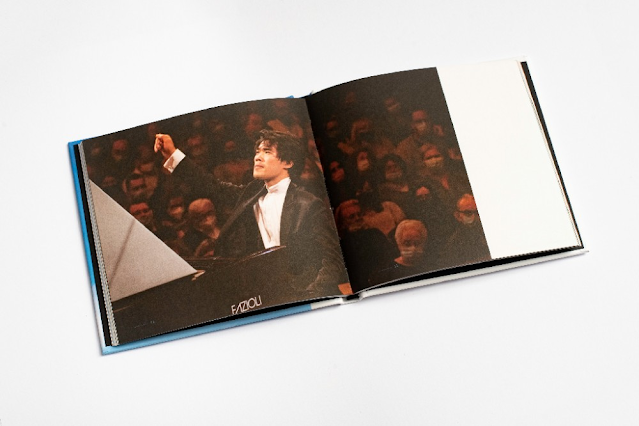Review of the National Chopin Institute CD of Competition Performances by the 18th International Chopin Competition winner of 2020, Bruce (Xiaoyu) Liu
| Bruce Liu CD number: NIFCCD 638 |
An outstanding recording in every dimension
This recording of competition performances of Bruce (Xiaoyu) Liu, the stunning winner of the latest Chopin Competition, is an exceptional album, much awaited by Polish and foreign music lovers alike. The FAZIOLI had a rich, unctuous tone under his fingers yet not lacking in brightness and sparkle when required.
The CD contains the lion’s share of the pianist’s performances recorded on the Chopin Institute label, including the Concerto in E minor. Together with the CD released by Deutsche Grammophon in November, by agreement with the Institute, it is a remarkable and complete document of Bruce (Xiaoyu) Liu’s triumphant road to victory in the world’s most important music competition.
Warsaw in October 2021 was home to consummate piano musicianship. The 18th Chopin Competition brought together the superbly talented virtuosos and was certainly one of the best in the nearly 100 years of the event’s history. Now those special moments can be recalled thanks to the technically brilliant recordings released by the Chopin Institute.
[1] Ballade in F major, Op. 38
Bruce (Xiaoyu) Liu gave a quite magnificent performance of the Ballade in F-major Op.38 which revealed his understanding of grand narrative structure in these works. The opening introduction possessed an affecting innocence, rather like a tender cradle song. Then a formidable surging of the passions, reminiscent of a portrait in music of the November Uprising of 1830 or the travails of the passions of love. Magnificent and noble. This gave way once again to a superb singing cantilena line of intense lyricism and narrative nostalgia. Fabulous articulation and wondrous grotesquerie in the rhythmic structure as well as inspired pedaling as passions erupted again like a volcano. A mercurial, nuanced and whimsical conception with great dynamic contrasts, superb rubato and phrasing that gave the work so much internal drive and excitement. It was clear to me at the time that he would be a finalist if not the winner.
[2] Rondo à la Mazur, Op. 5
Bruce (Xiaoyu) Liu presented a coruscating Rondo à la Mazur with a marvellous understanding of the embedded mazurka rhythm and immense variety within his appropriate elegant and brilliant, sparkling diamond-like, style brillante articulation. Such breathless excitement is generated that vibrates unmistakably along the spine by this sheer virtuosity and musicality. Complete dominance of the keyboard and instrument.
In an odd way perhaps, I felt it rather like listening to the transformation into music of an artistic and elegant Formula I Lotus racing driver like Jim Clark, in the most elevated sense. Michelangeli had a passion for Ferrari, Karajan for Porsche, Moran for Jaguar and Cahill for Alvis. Driving or playing at what is known as 10/10ths is just that - 100%. This 100% of your driving or playing skill means you are on the very limit of what you and the car or you and the piano can do. Liu does this on the piano and perhaps in his driving.
I mention this as Liu is obsessed by GoKarting and dreams of becoming a Formula I racing driver as well as a master pianist. There is a precedent. François Cevert was Jackie Stewart's devastatingly handsome Formula 1 teammate before his tragic death in 1973 at age 29, whilst qualifying in a Tyrrell at Watkins Glen in the US. He often played Beethoven in his paddock caravan before races and was a concert standard pianist. He was my youthful hero ...
 |
| François Cevert (1944-1973) |
 |
| Bruce (Xiaoyu) Liu |
 |
| Bruce (Xiaoyu) Liu at the wheel .... |
[3–6] Sonata in B flat minor, Op. 35
However, Bruce (Xiaoyu) Liu gave me rather mixed feelings concerning the Sonata in B-flat minor Op.35. I am unsure about the depth of his approach to the more serious works of Chopin. There is a faint atmosphere of the contrived and inauthentic wild emotionality in this fabulous playing. Emotionally we are left rather out in the cold in the, for me, overly tempestuous and high voltage tempo of the Grave. Doppio movimento. The Scherzo had superb articulation, colour, nuance and polyphony yet I remained emotionally unmoved. Perhaps it was played too heavily for a scherzo, even a Chopin scherzo which are scarcely 'jokes' in the Italian sense. The cantilena sang with superb legato but perhaps I was in an unreceptive mood on the day? Was I now 'Chopined out' after such intense, unremitting exposure to his music day and night?
I felt the Marche funèbre not atmospheric enough, rather laboured without the ominous metaphysical shadow of death hovering menacingly above us all as it had been with Gagliano, Gadjiev, Condotti and Sorita. The cantilena had ravishing tone and simplicity, yearning and innocence of the grief of lost joys but I kept asking what was the pianist actually saying to me, to my heart ? Were these expressions of nostalgia ? Melancholic regret? The return of the Marche funèbre sotto voce was very moving. The Presto displayed once again his fabulous command of polyphony and keyboard technical facility. Does it symbolize a metaphysical wind rushing over the graves or the mind unhinged by the torments of the wrenching grief of loss? Perhaps it simply indicates relatives and friends of the deceased gossiping affectionately after the funeral as they tend to do. This was perhaps Chopin's preferred, rather ironic, interpretation, at least according to his own description of the movement.
I feel Liu is a great pianist but not yet a great artist in the deeper sense. Competition victories are only the beginning of that long road to artistic mastery. This was clear in the Variations on Don Juan and the Andante spianato & Grande Polonaise brillante (not on this recording but on Deutsche Grammophon)
These works suited to perfection his spectacular and astonishing style brillante display of pyrotechnics and overwhelming keyboard skills, his dazzling and radiant cosmetic sense of style. Here he far excelled everyone in the competition.
[7–9] Piano Concerto in E minor, Op. 11
Some important cultural context for you concerning the concerto before reading the review
 |
| The Young Chopin in 1829 Ambroży Mieroszewski (1802–1884) |
 |
| Warsaw Panorama from Praga 1770 - Bernado Bellotto |
Romanze. Larghetto
Rondo. Vivace
Chopin wasted no time in composing his next concerto in 1830 after the first in F minor.
In many ways the E minor concerto revolves around the exalted Romanze. Larghetto central movement. He elucidated its inspiration to his friend Tytus Woyciechowski: ‘Involuntarily, something has entered my head through my eyes and I like to caress it’.
The Warsaw premiere audience numbered around 700. ‘Yesterday’s concert was a success’, wrote Chopin on 12 October 1830 to Tytus ‘A full house!’ Two young female singers also performed at the concert conducted by that controversial figure in Warsaw musical life, Carlo Soliva. Contemporary programming was unimaginably different to 2021. After the Allegro had been played to ‘a thunderous ovation’, Chopin sacrificed the stage to a singer [‘dressed like an angel, in blue’], Anna Wołkow. Typical of the pressing personality of Soliva, she sang an aria he had composed.
The other young singer was Konstancja Gładkowska. Chopin wrote as descriptively as always: ‘Dressed becomingly in white, with roses in her hair, she sang the cavatina from [Rossini’s] La donna del lago as she had never sung anything, except for the aria in (Paer’s) Agnese. You know that “Oh, quante lagrime per te versai”. She uttered "tutto desto” to the bottom B in such a way that Zieliński (an acquaintance) held that single B to be worth a thousand ducats’.
This 'farewell' concert was only three weeks before Chopin left Warsaw and the subsequent November 1830 uprising burst upon the city. ‘The trunk for the journey is bought, scores corrected, handkerchiefs hemmed… Nothing left but to bid farewell, and most sadly’. Konstancja and Frycek exchanged rings. She had packed an album in which she had written the words ‘while others may better appraise and reward you, they certainly can’t love you better than we’. Only two years later, Chopin added: ‘they can’ which speaks volumes.
An introductory book on the concertos and their context I cannot recommend more highly:
Chopin - The Piano Concertos by John Rink (Cambridge Music Handbooks 1997)
Bruce (Xiaoyu) Liu
Warsaw Philharmonic Orchestra
Andrzej Boreyko
Fryderyk Chopin - Concerto in E-minor Op.11
Allegro maestoso
The work opened with a powerful declaration of intent. His LH was prominent in counterpoint and his tone in bel canto quite ravishing and emotionally moving. The style brillante was light, airy and virtuosic as it should be. One could hear all the LH detail which added significant depth to the landscape and exegesis of various themes. His tone and touch are elegant, rich and graceful. There is distinguished refinement, subtle dynamic sensitivity and aristocratic bon gout in this playing. Yet at times I felt certain expressive gestures were more rushed than expected - perhaps simply as a result of a keyed-up, competition nervous system! A light, glistening glitter like pearls falling on glass were scattered over us. His thirds are spectacular and only comparable to Horowitz. I felt the plumbing of emotional tragedy which occasionally and painfully fissures this movement was rather absent. Fine co-ordination with the outstanding Warsaw Philharmonic orchestra under their sensitively sympathetic conductor Andrzej Boreyko.
Romanze. Larghetto
Great simplicity, a touchstone of the composer, was evident here in a seductive fashion. The aria, a true nocturne taken at dusk in a garden or in moonlight on the still waters of a lake, moved forward in clusters of expressive tension and relaxation. This was true singing on the piano. A lovely duet with the bassoon evolved. Rich in colour, his phrasing was beautifully sculptured into touching poetic shapes replete with emotional expression of an affecting and poignant kind. The movement faded with fatalistic inevitability into the dreamworld from which it had originally emerged. A magician who hypnotized us.
Allegro vivace
This was perfect krakowiak both in engaging and vitalizing rhythm and Polish spirit. The expression was so gloriously varied in articulation, colour, timbre, dynamic and above all, the affected charm of the style brillante. Eloquent counterpoint in the LH balanced with the RH once more spoke volumes.The FAZIOLI instrument supported him and the internally fizzing yet richly rounded tone and incandescent sound world to perfection. There was so much life, verve and vivacity invested in the expression. This was fiery energy without crudity of tone or dynamic in an exuberant display that one was privileged to hear live. A tremendous, overwhelmingly symphonic conclusion in the coda. One must also reflect on the genius of Chopin in winding up the virtuosic tension to such a formidable pitch of thermodynamic intensity.
The audience were quite beside themselves with enthusiasm and leapt to their feet, shouting their emotional release for five minutes at least. I have only experienced this once before with Vladimir Horowitz in London (but actually this was on his entrance to the stage before he played a note!).
Liu must sweep the floor with the rest of the competitors into First Place.
And the audience went absolutely wild!
The tumult that erupted is atmospherically recorded too!
This is an indispensable recording for any serious Chopinist or as an addition to monuments of modern performance in a contemporary record library
To purchase :
https://sklep.nifc.pl/index.php?produkt=2_185&jezyk=eng
or







Even in the digital age, the CD retains significance. It offers a tangible connection to music, with its cover art and booklet, preserving an era of music appreciation.
ReplyDelete